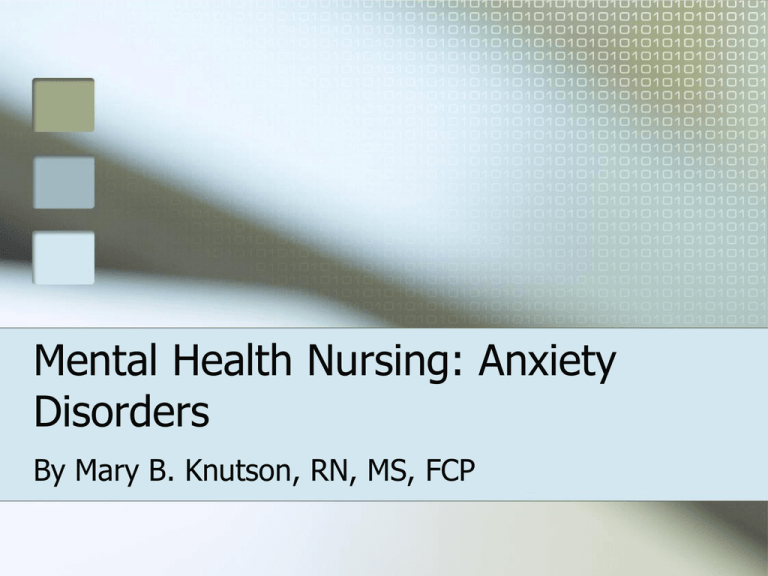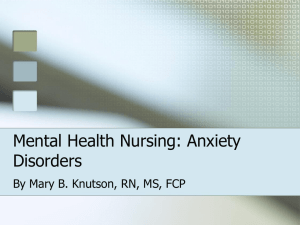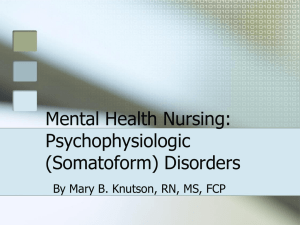Mental Health Nursing: Anxiety Disorders
advertisement

Mental Health Nursing: Anxiety Disorders By Mary B. Knutson, RN, MS, FCP A Definition of Anxiety Diffuse apprehension that is vague in nature and associated with feelings of uncertainty and helplessness Levels of Anxiety Mild: Tension of day-to-day living Moderate: Focus on immediate concerns Severe: All behavior is aimed at relieving anxiety Panic: Dread, terror, abrupt distress Details are blown out of proportion Disorganization of personality Increased motor activity, physical sx Loss of rational thought Autonomic Nervous System Sympathetic body processes: “Fight or flight” reaction (epinephrine) respirations, BP, and heart rate Blood shifts away from GI tract to heart, central nervous system, and muscle Blood glucose level rises Tension, restlessness, tremors, pacing, fear, sweating, face flushed or pale Parasympathetic body processes can coexist: “Breed or feed” reaction Mild or Moderate Anxiety Frequently expressed as anger Self-esteem is related to anxiety May be caused by frustration Often not a medically diagnosed health problem Moderate or Severe Anxiety Neurosis: Maladaptive anxiety disorder without distortion of reality Psychosis: Panic level “breaking into pieces”, and fear of inability to cope Anxiety and depression symptoms can overlap: Sleep disturbance, appetite changes, cardiac and GI problems, poor concentration, irritability, or change in energy level Somatoform Disorders Psychophysiological disruptions with no organic impairment, related to anxiety May have illness, disability, pain, or sleep disturbance Unconscious coping with anxiety or overwhelming stress Provide a way to receive help, without admitting the need May protect from expressing frightening aggressive or sexual impulses Somatoform Illnesses Somatization disorder- many physical complaints Conversion disorder- loss or alteration of physical functioning Hypochondriasis- fear of illness or belief that one has an illness Body dysmorphic disorder- normal appearance, but concerned about physical defect Pain disorder- involving psychological role Sleep disorders- usually insomnia Predisposing Factors Psychoanalytical Interpersonal Behavioral Family Biological perspectives Precipitating stressors include threats to physical integrity and self-system Alleviating Factors Coping resources include intrapersonal, interpersonal, and social factors: Economic assets Problem-solving abilities Social supports Cultural beliefs Medical Diagnosis Panic Disorder with or without agoraphobia (fear of being in places unable to escape, or in embarrassing situations) Phobia: Excessive and persistent fear Obsessive-compulsive disorder Posttraumatic stress disorder Acute stress disorder Generalized anxiety disorder Examples: Nursing Diagnosis Fear related to financial pressures evidenced by recurring episodes of abdominal pain. Severe anxiety related to family rejection evidenced by confusion and impaired judgment. Ineffective individual coping related to illness evidenced by limited ability to concentrate, and psychomotor agitation. Nursing Care Assess subjective and objective responses Recognize defense mechanisms Task-oriented reactions: Attack, withdrawal, compromise Ego-oriented reactions: Compensation, denial, displacement, dissociation, identification, intellectualization, introjection, isolation, projection, rationalization, reaction formation, regression, repression, splitting, sublimation, suppression, or undoing Implementation Establish trusting relationship Monitor self-awareness Protect the patient Modify the environment Encourage activity Administer medication Recognize anxiety Utilize pt insight to cope with threats Promote relaxation response Anti-anxiety Drugs Benzodiazepines Alprozolam (Xanax) Clonazepam (Klonopin) Diazepam (Valium) Lorazepam (Ativan) Chlordiazepoxide (Librium) Chlorazepate (Tranxene) Oxazepam (Serax) Halazepam (Paxipam) Prazepam (Centrax) Anti-anxiety Drugs (continued) Antihistamines Diphenhdramine (Benadryl) Hydroxyzine (Atarax) Noradrenergic agents Clonidine (Catapres) Propranolol (Inderol) Anxiolytic Buspirone (Buspar) Antidepressant drugs may also be helpful to reduce anxiety Evaluation Patient Outcome/Goal Patient will demonstrate adaptive ways of coping with stress Nursing Evaluation Was nursing care adequate, effective, appropriate, efficient, and flexible? References Stuart, G. & Laraia, M. (2005). Principles & practice of psychiatric nursing (8th Ed.). St. Louis: Elsevier Mosby Stuart, G. & Sundeen, S. (1995). Principles & practice of psychiatric nursing (5th Ed.). St. Louis: Mosby







